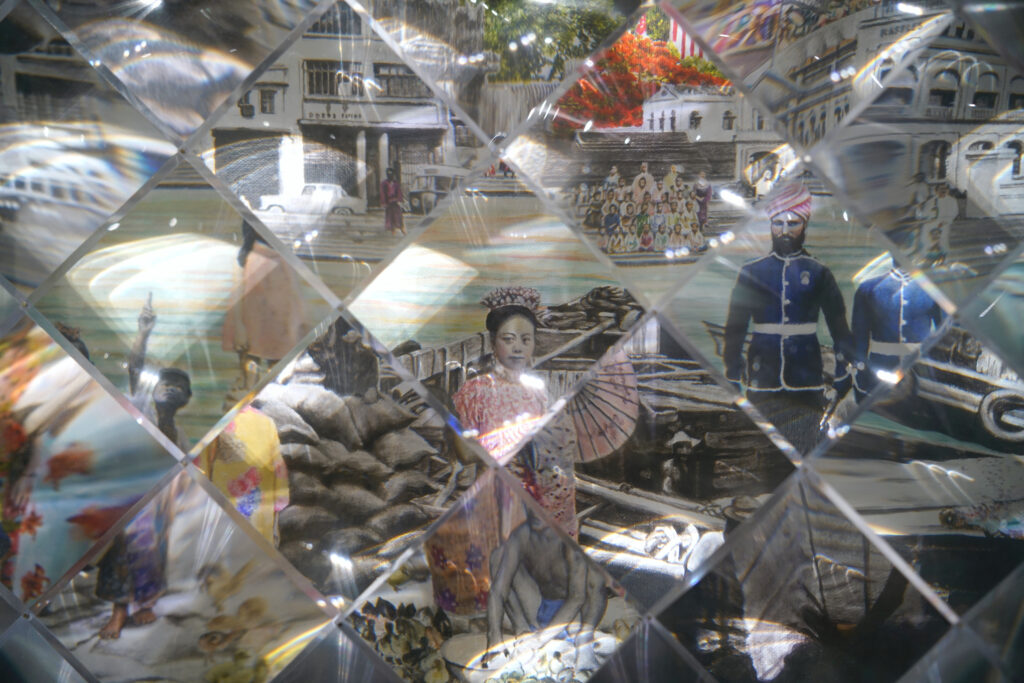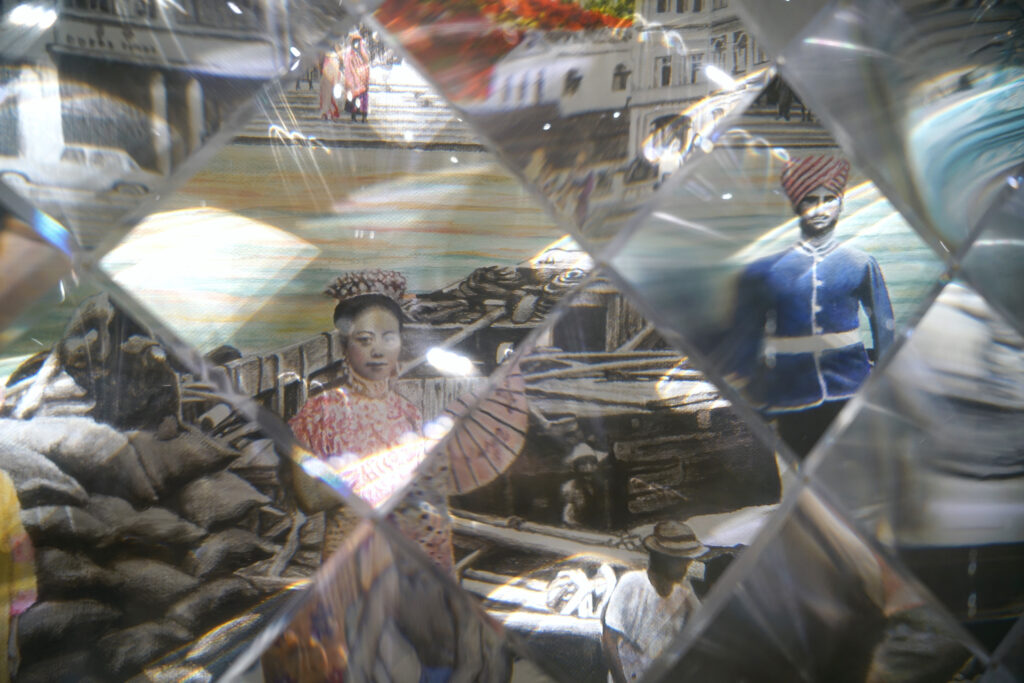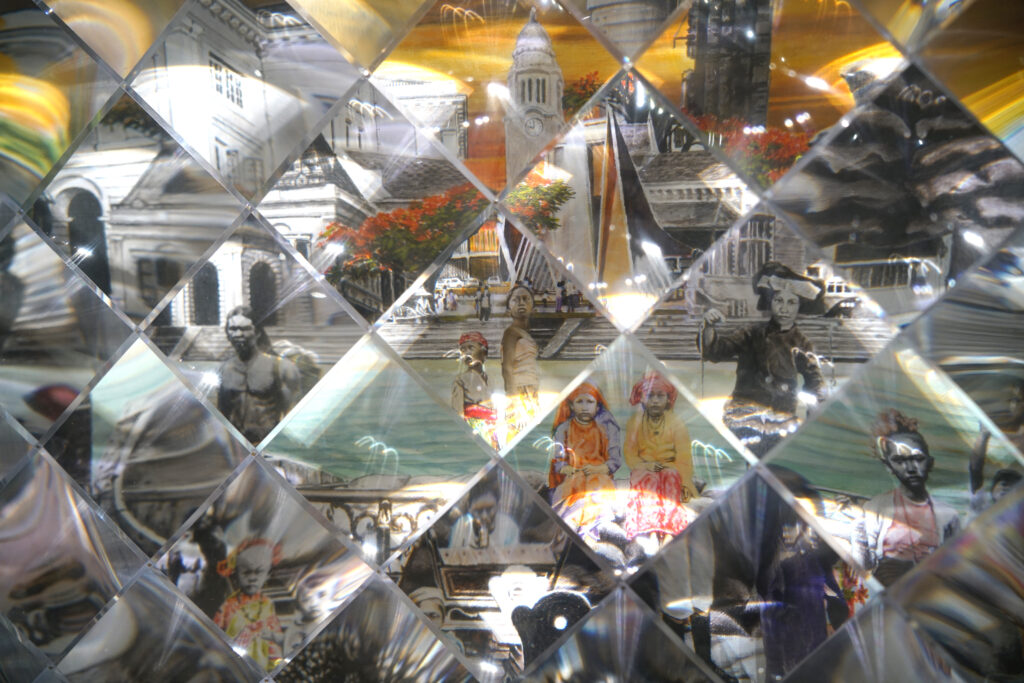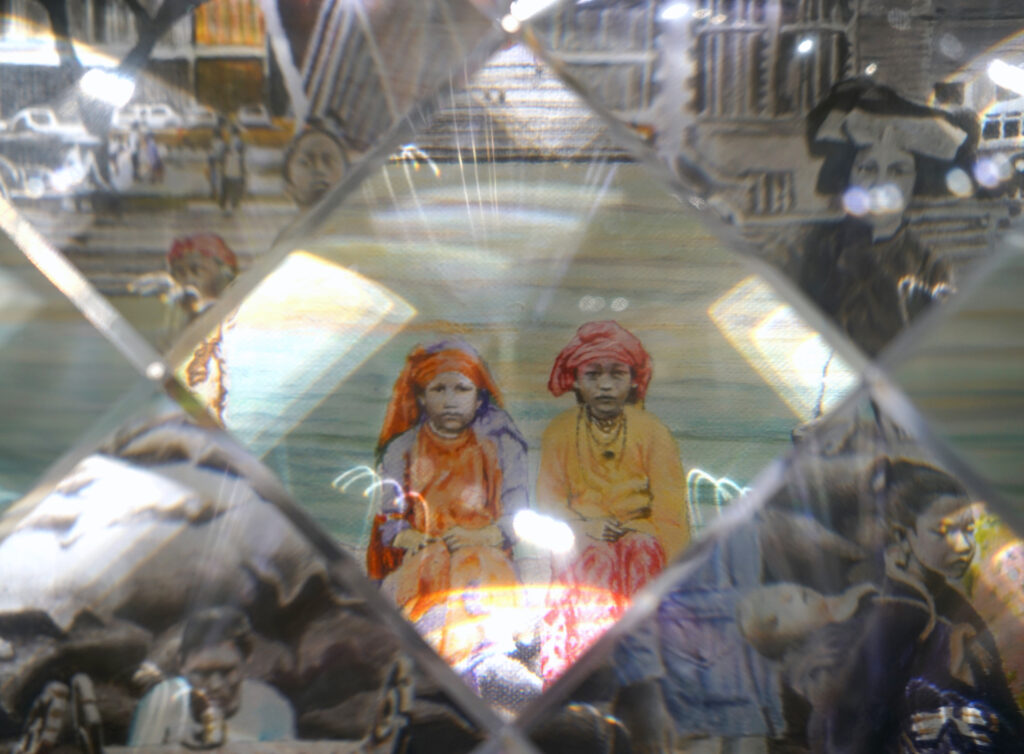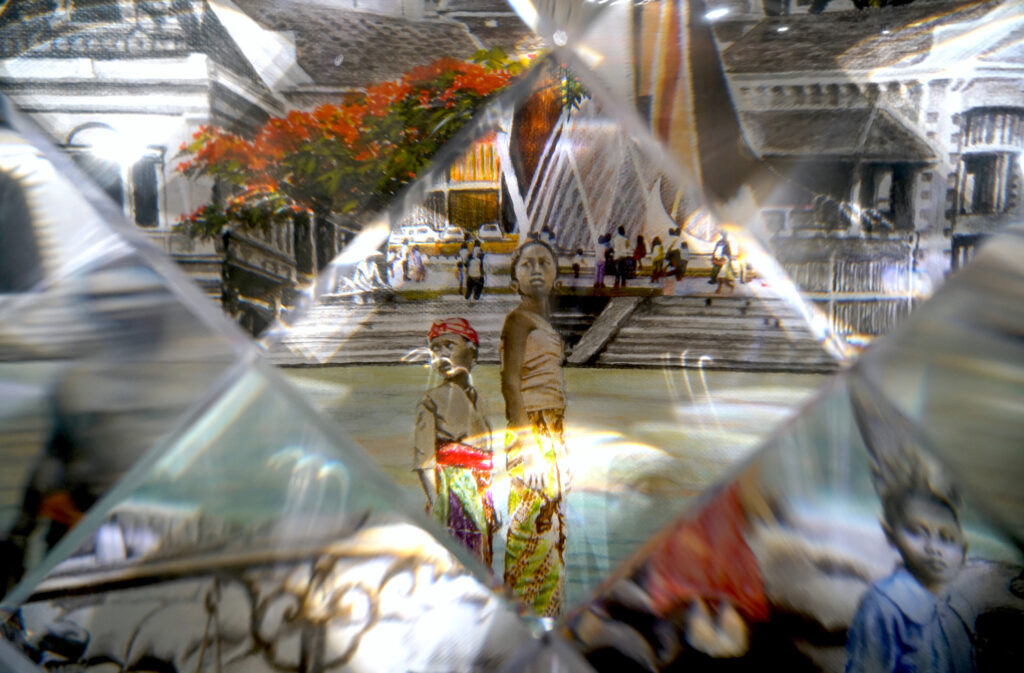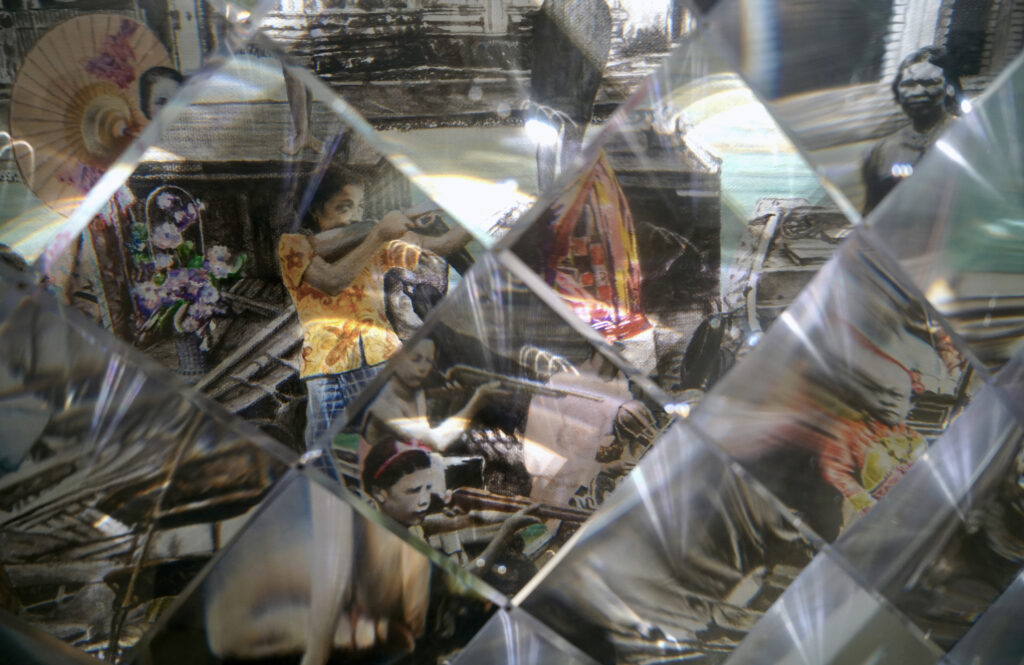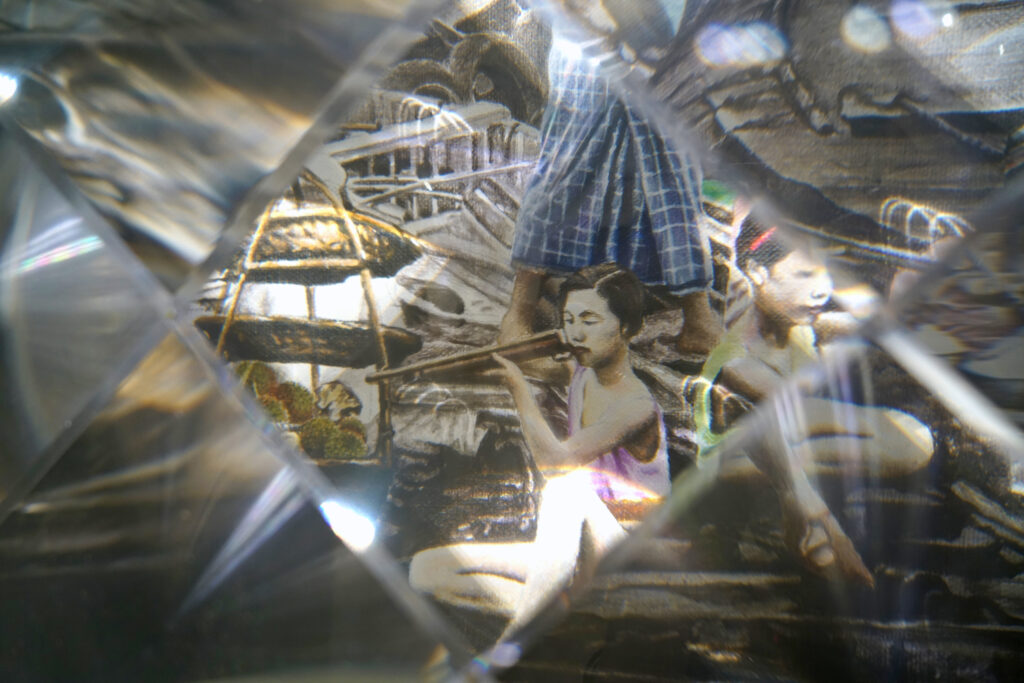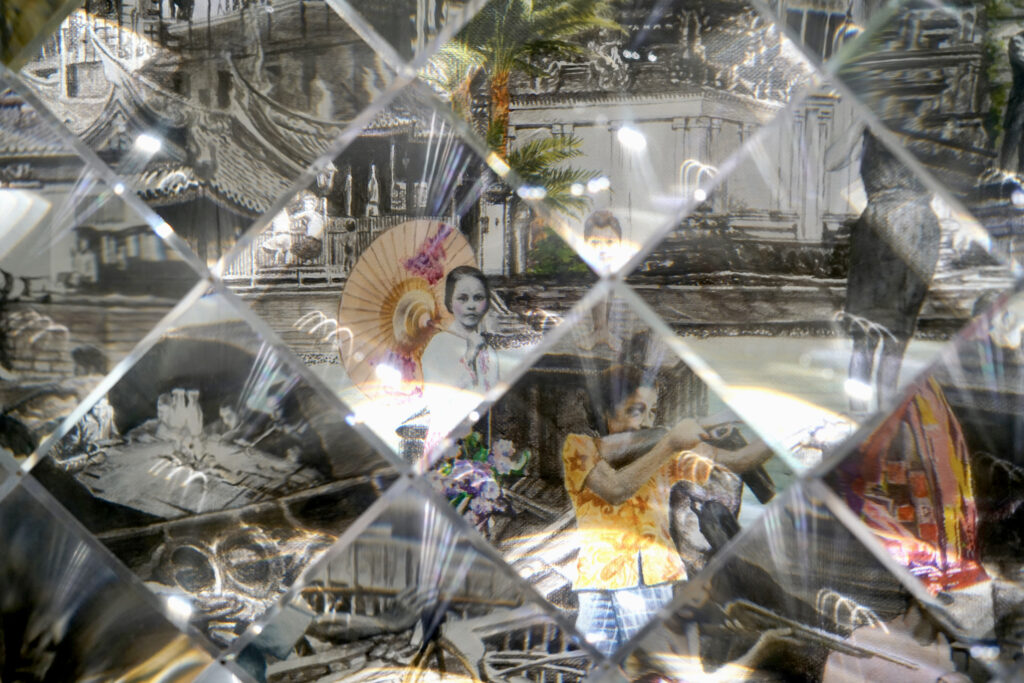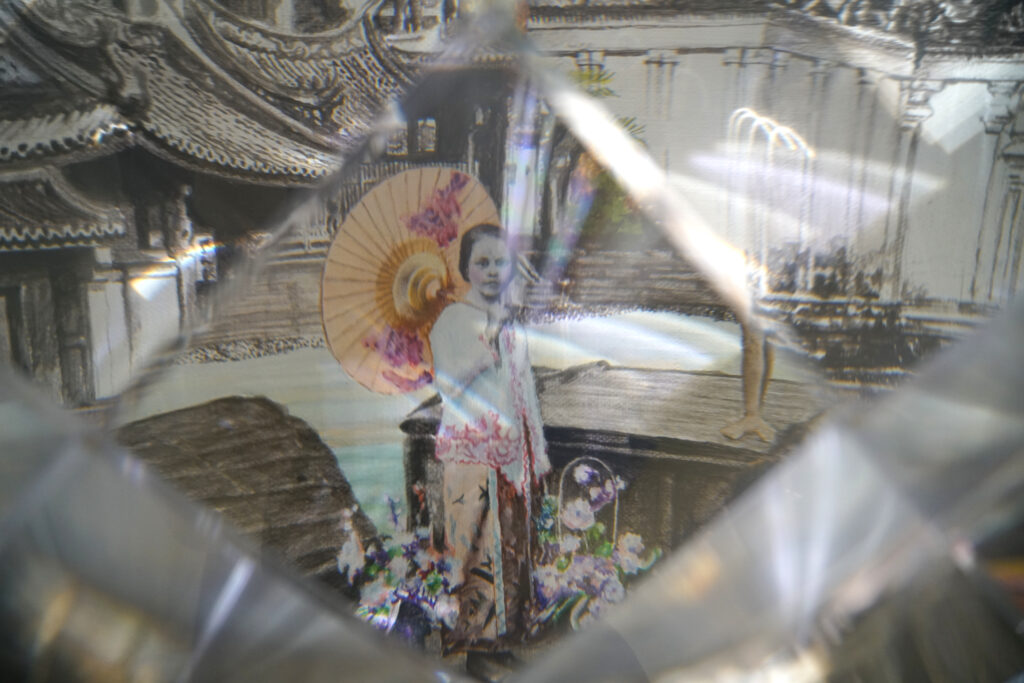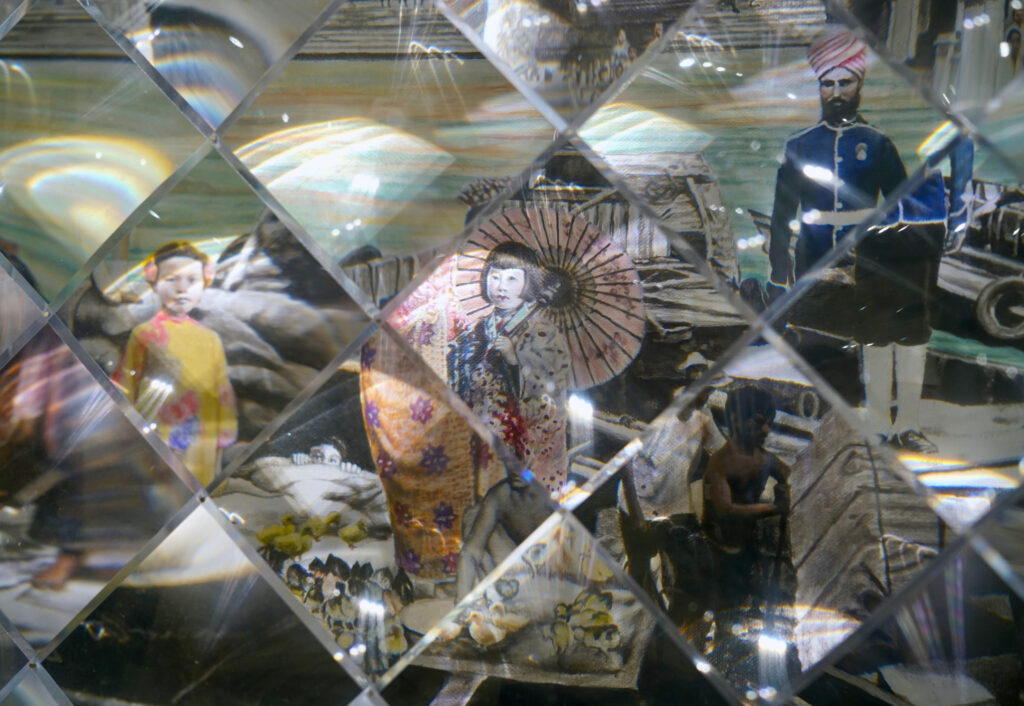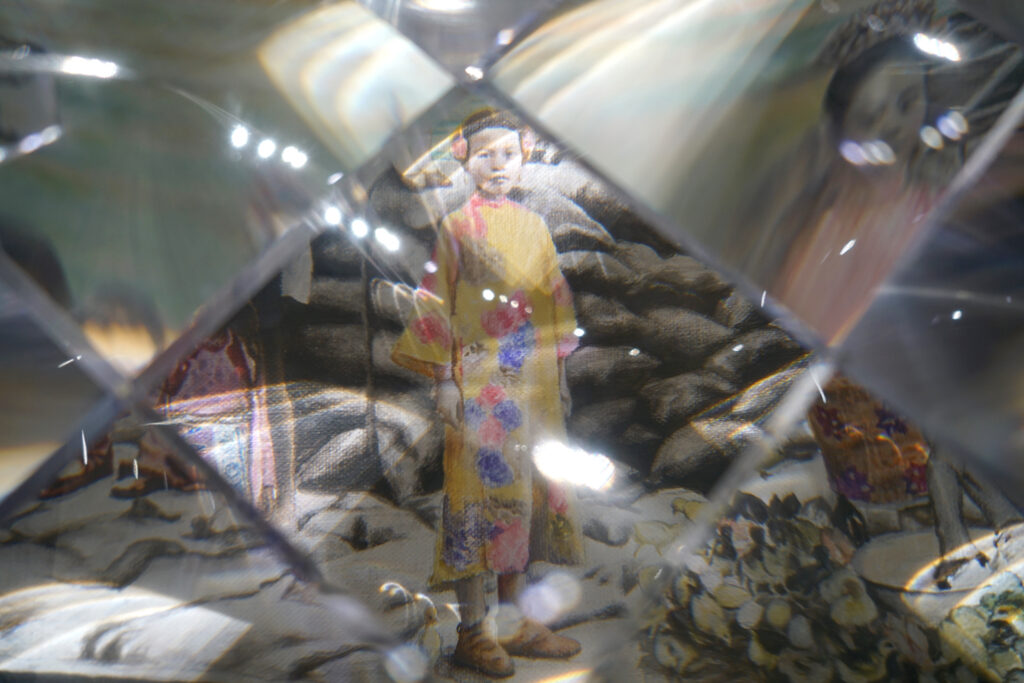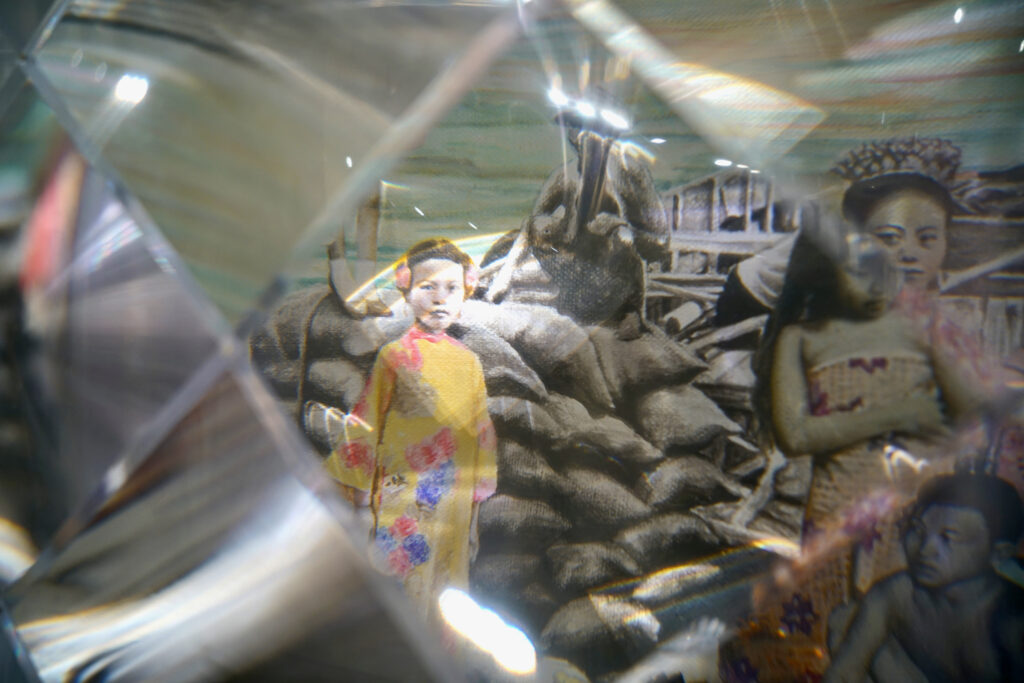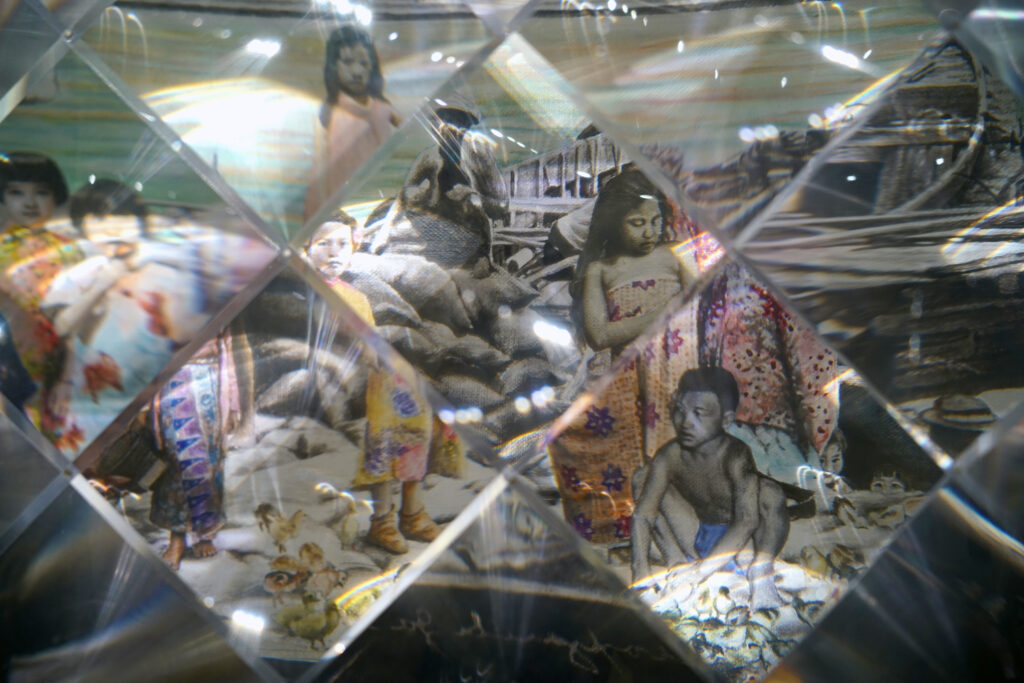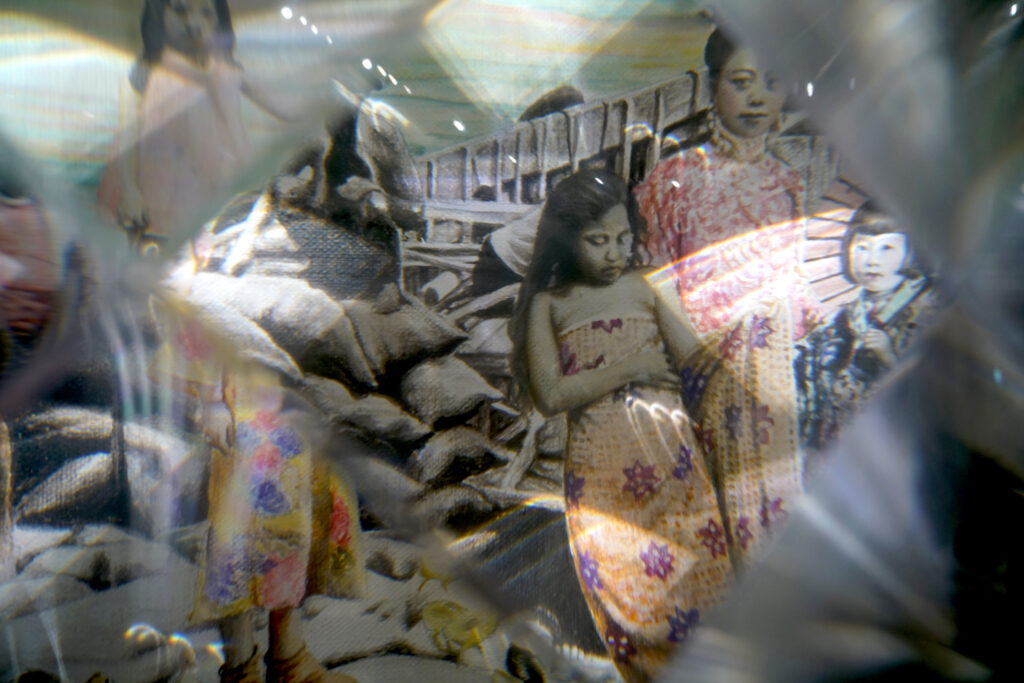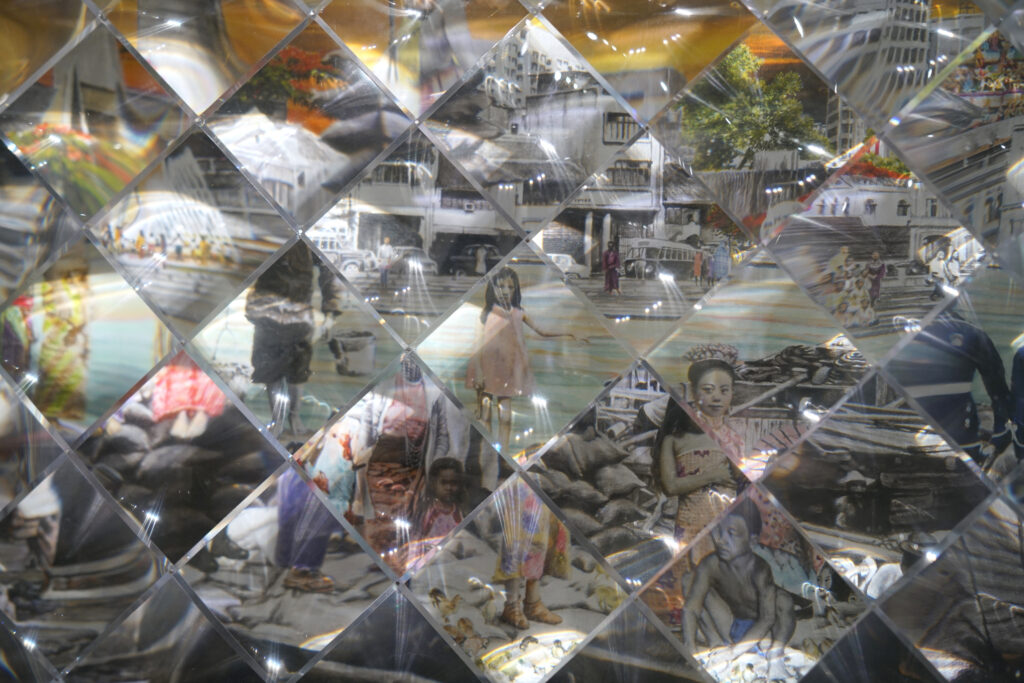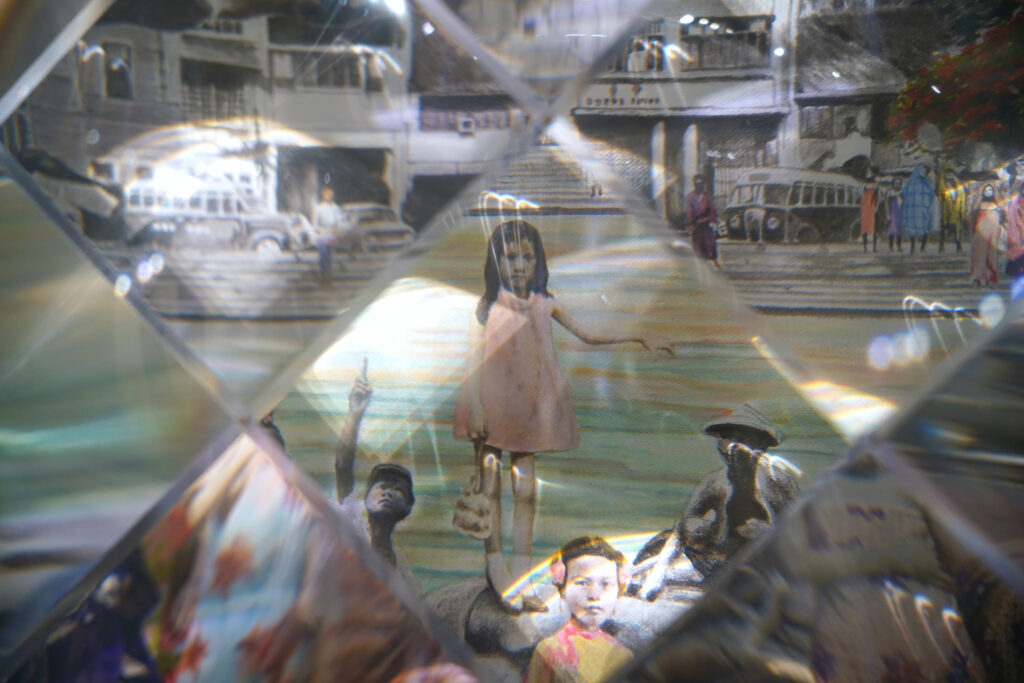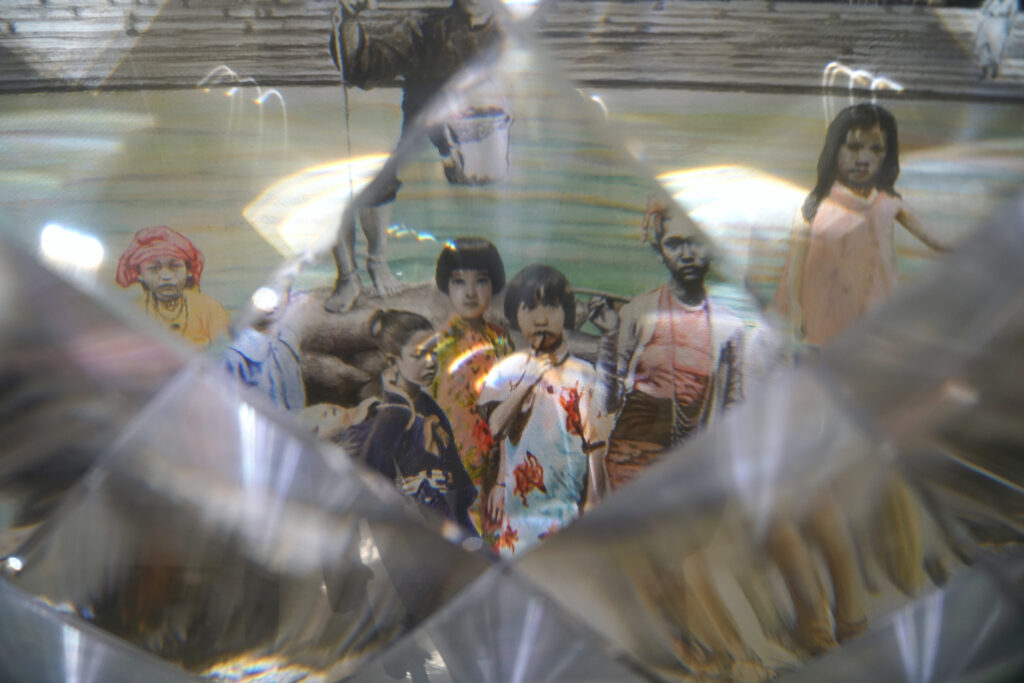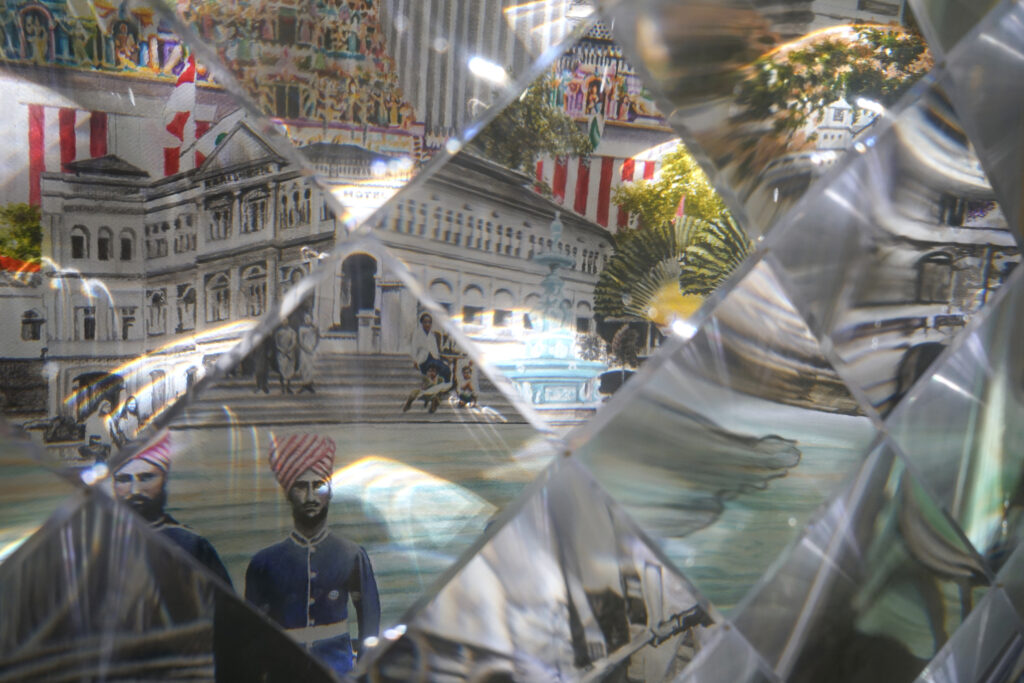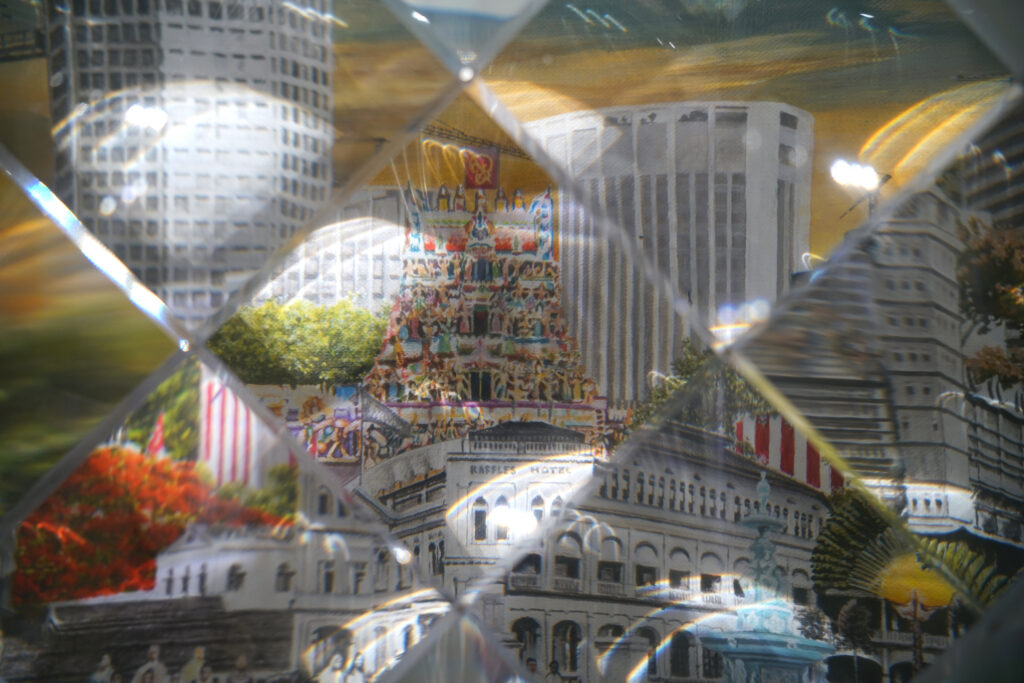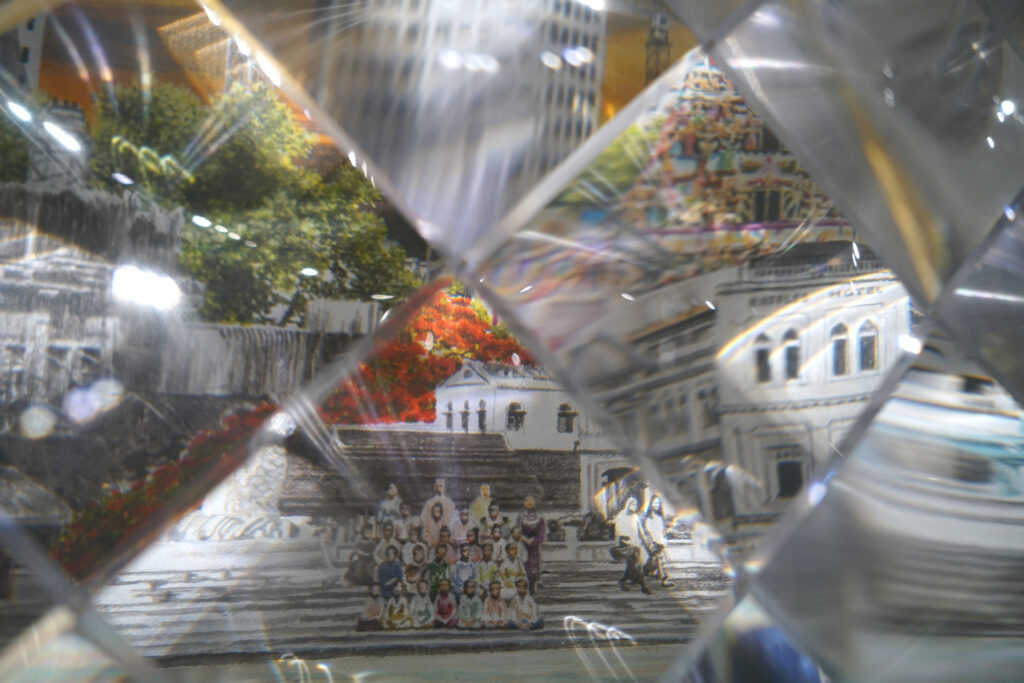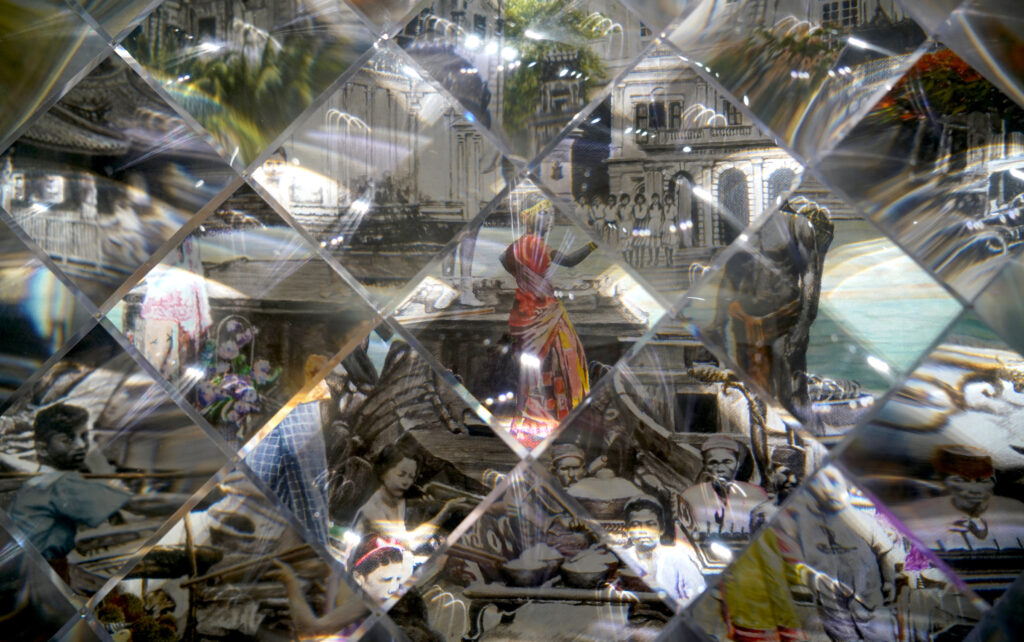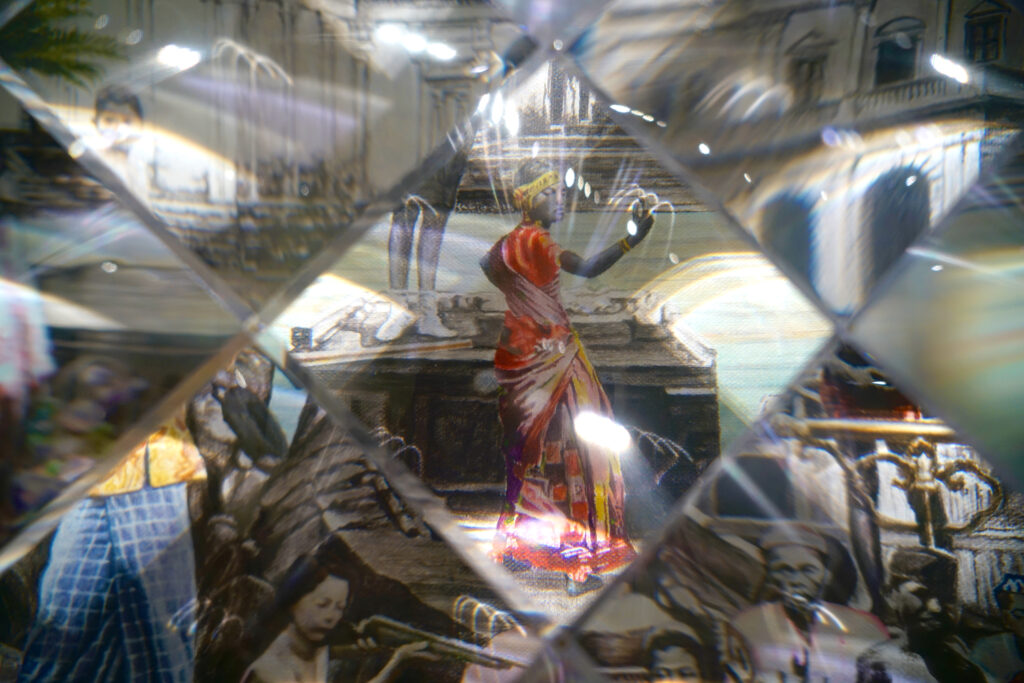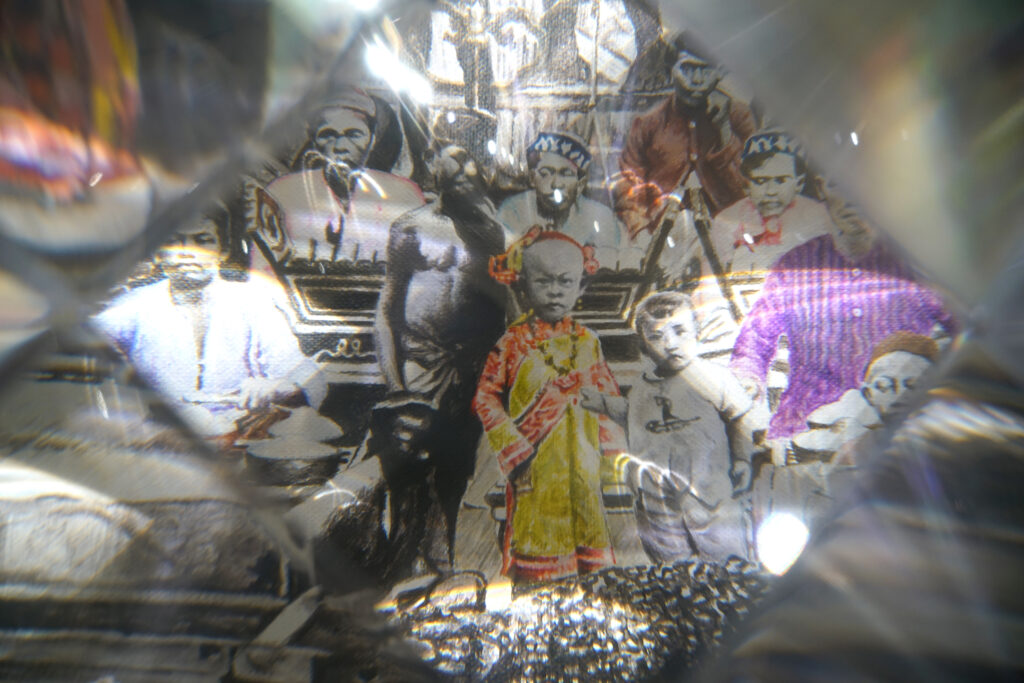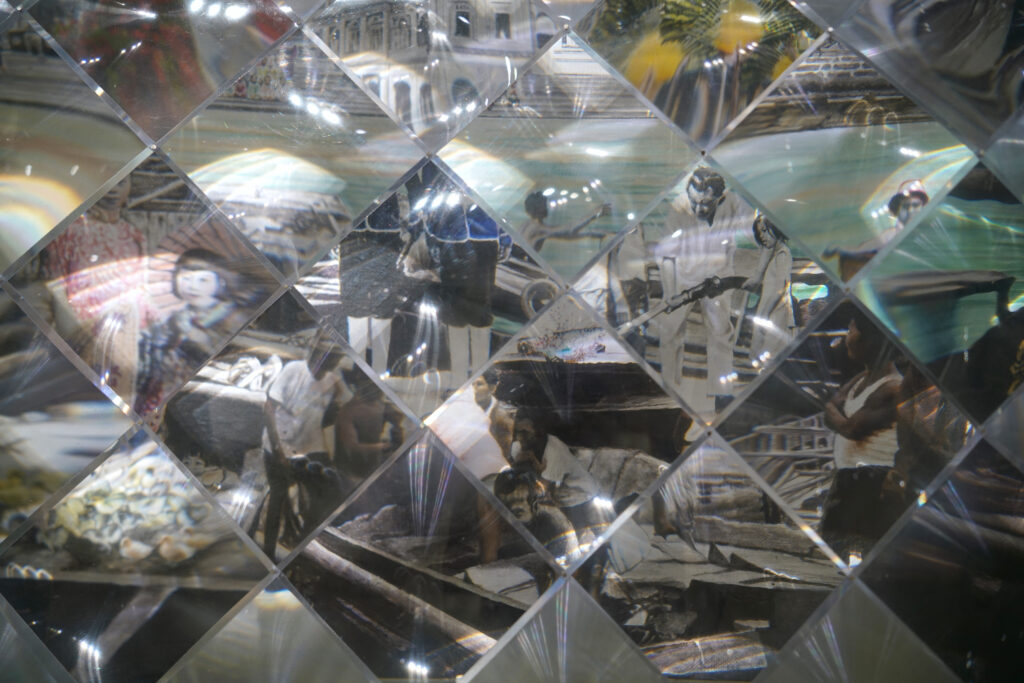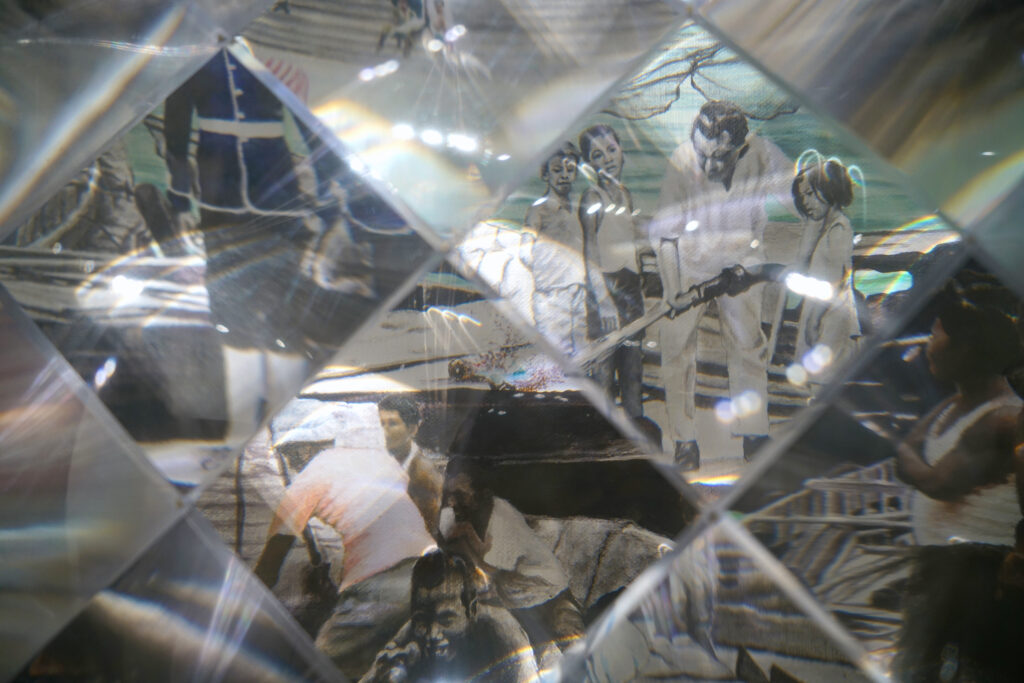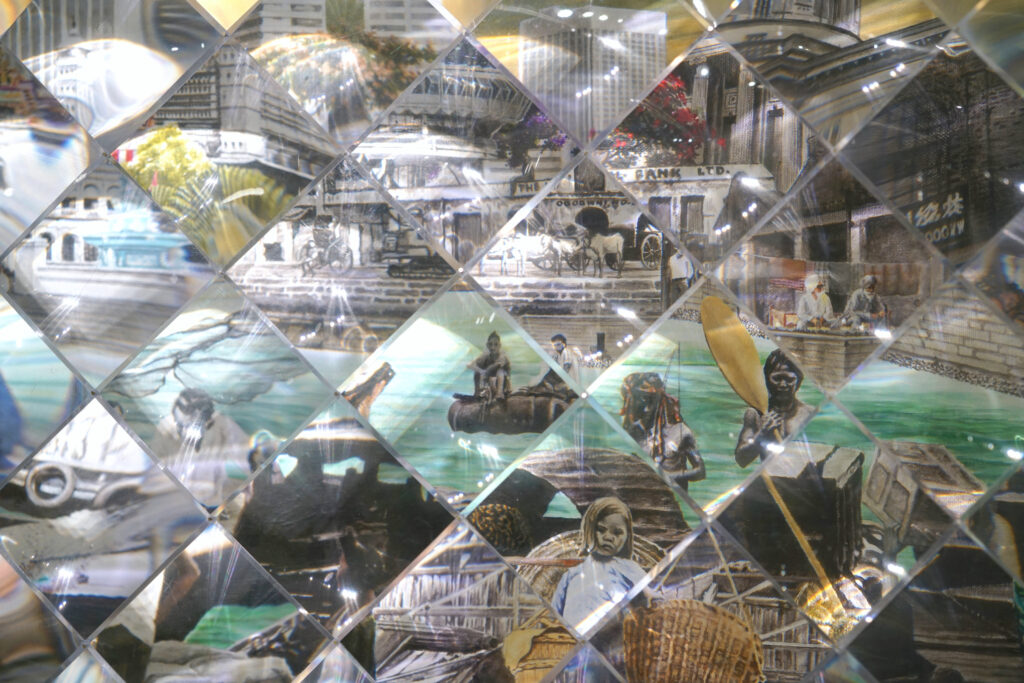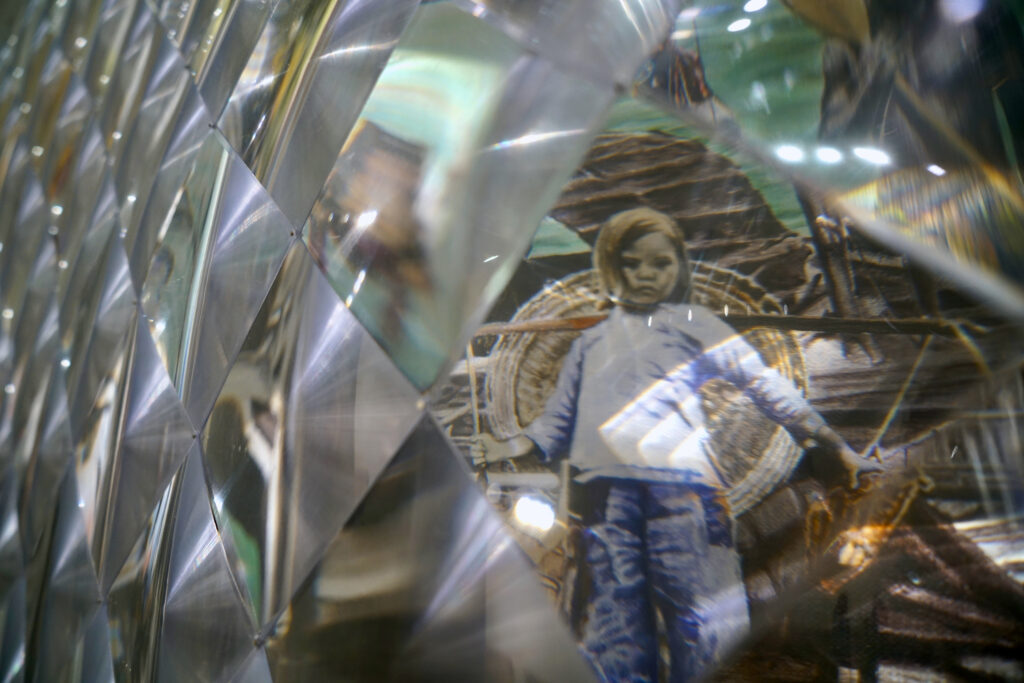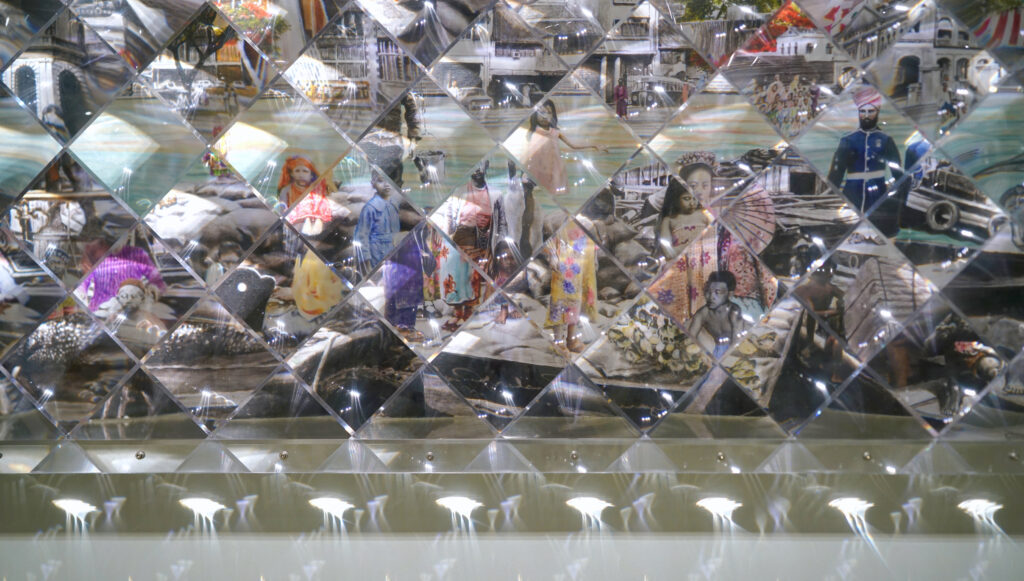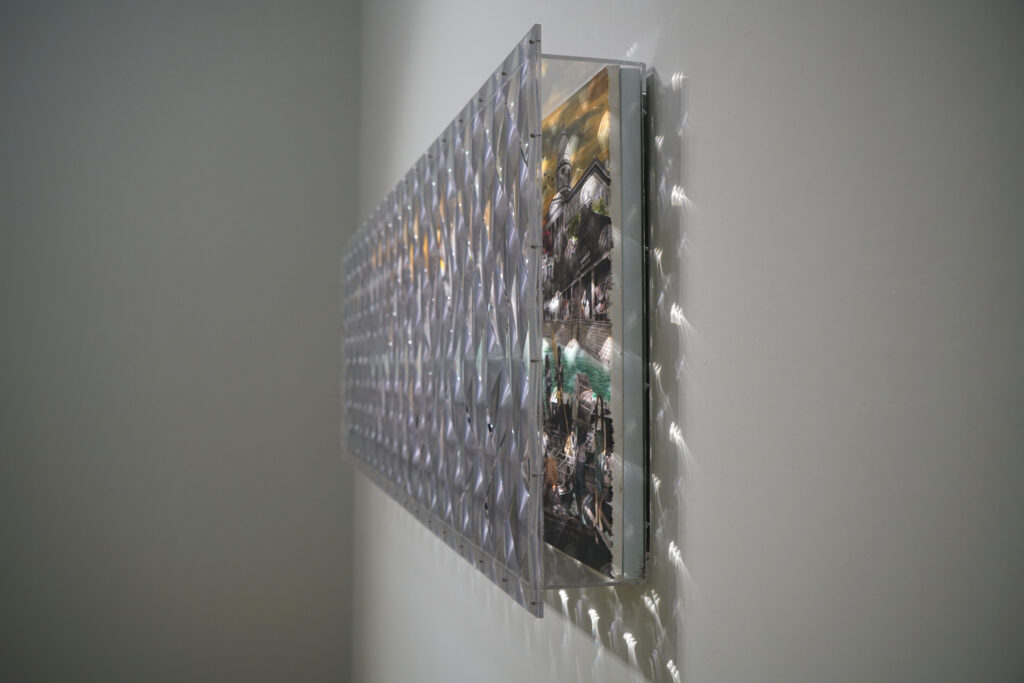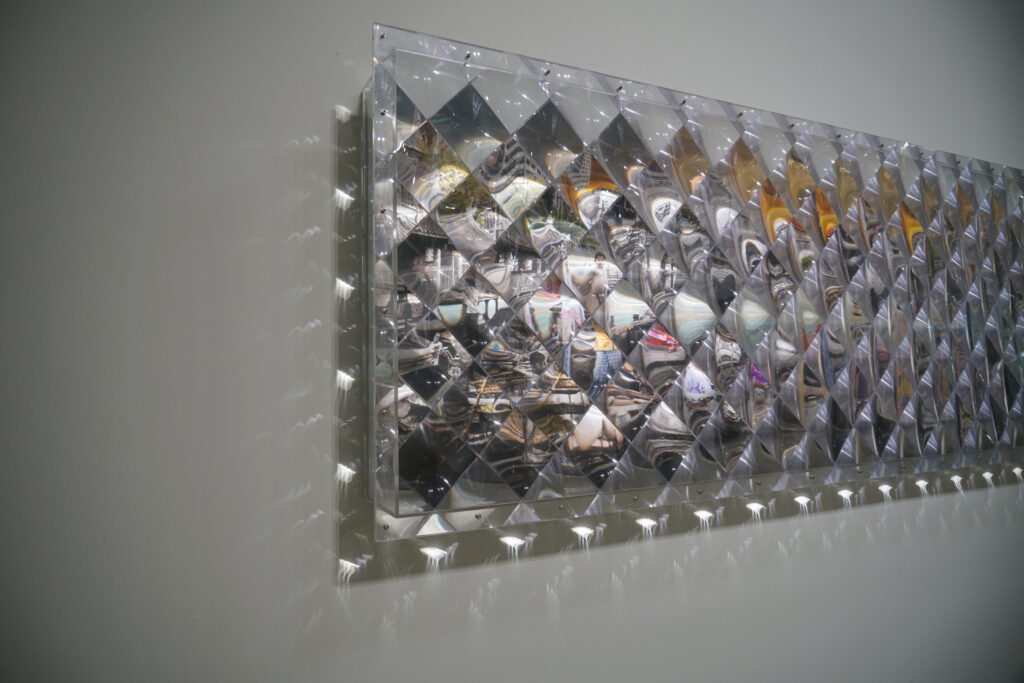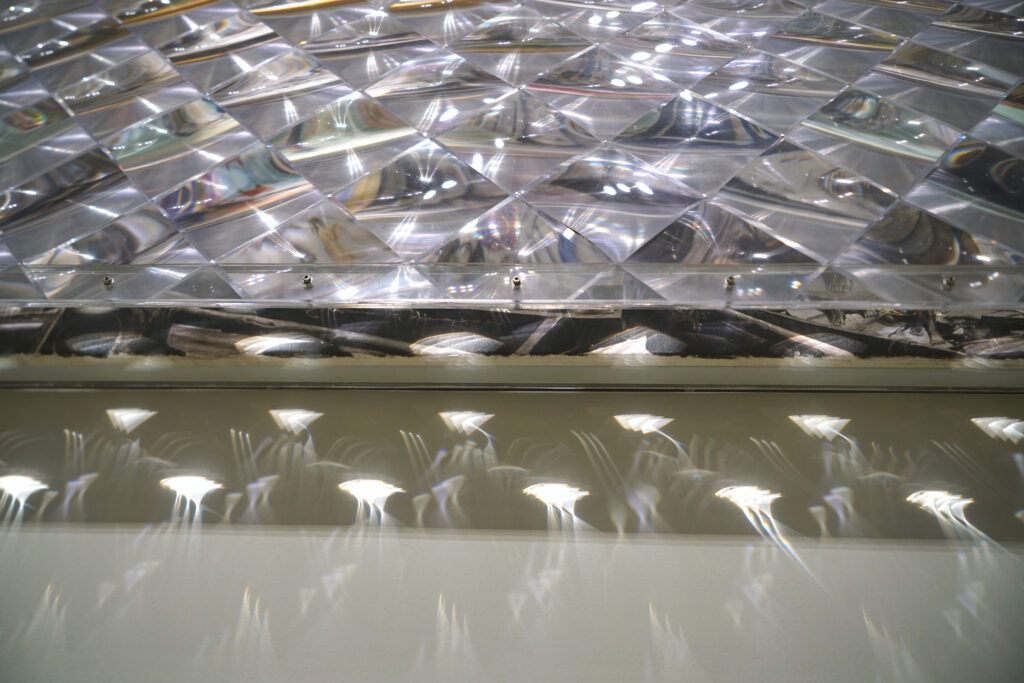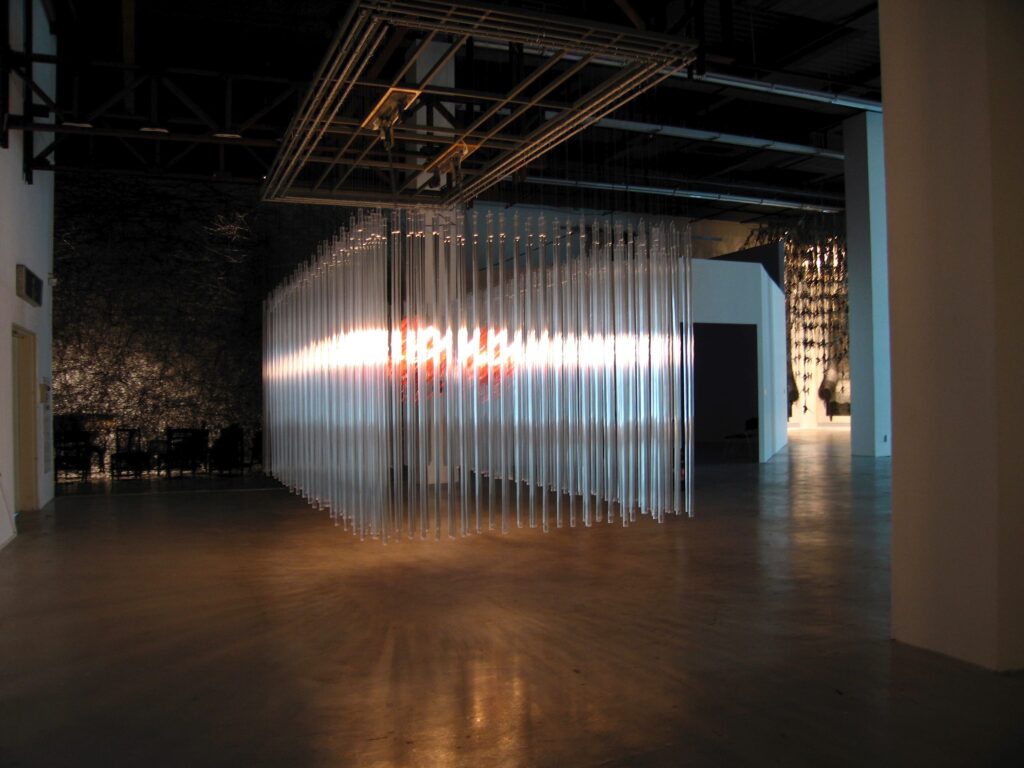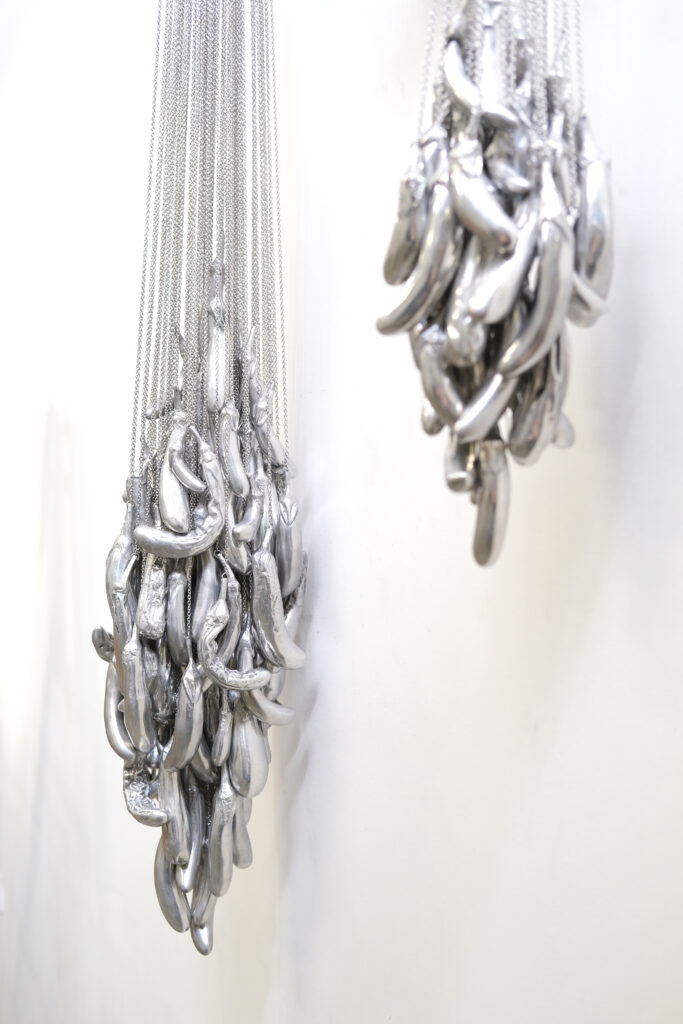Artist Statement
Featuring an optically restless suite of works, the Lens-Painting Series rematerializes the ethnographic postcards of Southeast Asia from moments of early colonial encounter into a complex hand-painted tableaux that generate spaces of pictorial privacy and self-mapping for the colonized subject. Ensconced behind a screen of lenses, never at once can the entirety of the image be seen clearly.
In this departure from engaging directly with fully visible artworks, the audience is confronted instead by a “lens-scape” that functions as a site through which paintings are encountered. As an optical interface, the lenses become a contradictory medium that obscures while also bringing the image into focus – contingent always upon the viewer’s position and angle of observation.
Lenses dilate vision. As the spectator peers through this field of “compound eyes” into the picture, random details are magnified, dissected and dislodged, coalescing as an atlas of ever-shifting boundaries that morph, blend and clash as the viewer adjusts vantage point. Such discontinuous ways of seeing, at the cost and in isolation from the whole, produces an optical decomposition; the pictorial narrative is kaleidoscopically cut up by the lenses - turning order into disjuncture, flatness into depth, the singular into the multiple, and the static into the kinetic (image and viewer).
As magnification inflates size and scale to create the intimacy of close-ups, peripheral areas get indiscriminately buried from sight. Locating what has slipped away from view seems only to rouse the kinetically-engaged viewer, who far from striking a pose of contemplative stillness, ends up extending, retracting, bending, leaning or elevating the body to hunt and seek what eluded their initial observation.
The painted scene, set anew against the backdrop of the historic Singapore River, presents vistas of de-exotica - a self-designated term for the human subjects, flora and fauna, lost buildings and paraphernalia that have been de/recontextualized from their perceived otherness, originally portrayed in the postcards of Southeast Asia from the1920’s-60’s. Shot and captured by the colonial gaze behind the camera, these postcard-photos had sought to subjugate and fabricate the Indigenous as the “exotic Other”. Whilst this term can be used as agency in some quarters, it describes a status of inferior “foreignness” in one’s own land levied upon by a colonial-oppressor that locates itself as the centre from which all else is reframed as Other.
Destined for circulation in the knowledge economies “back home” in Europe, the postcard, an early equivalent of today’s Instagram, was intended for the gratification of Western ethnographic curiosity. For the documented subjects however, whose images had been extensively replicated for dissemination, the postcard was a manipulative vehicle for their unwitting participation in self-perpetuating cycles of alterity.
In the open landscape, at work, on the street, propped amongst props of exoticizing studio paraphernalia, as a family, as a community, with children or alone - such was the colonial camera’s intrusion into personal and communal privacy. Caught in mid-stride or surprise, modelling docile poses, shielded only by guarded looks, defiant stare-downs, undisguised self-consciousness, indifference, the rare smile – these often meet the glare of the camera’s all-seeing eye. Such responses attest to the presumptive treatment of the colonised subject as compulsorily available, visible and knowable, rather than a privilege to be negotiated or granted. ‘Shooting’ with the camera often led to shooting down the boundaries of Self. To restate the words of art historian Teju Cole, the camera, a tool of imperialism became a weapon that aided in violating the human right and dignity to remain “obscure, unseen and dark”.
With its methods of optical dissection and disarray, the Lens-River Series presents an ethnography of illegibility as a measure of loss, only to be reclaimed by an agitated performance of indeterminacy augmented by lenses. Purposeful optics. By re-locating the ethnographic subject behind a territory of lenses, no one is on call to be ‘fixed’ anymore. The imperial act of invasive seeing versus the colonised subject’s liability and vulnerability of being seen becomes continually impeded and renegotiated. By angling to grasp the whole image, the viewer/voyeur is led to come to terms with the figures’ complex elusiveness and ultimate unknowability.
This iterations in the series free up the colonial timelines, junctures and narratives of landscape, race, culture and practices to be collectively compressed upon the picture plane as a singular re-imagined present moment. This reclamation of innate belonging, ownership, familiarity, community and connection featured subjects including kampong folk, fishermen, Samsui women labourers, Sikh guards, rifle-wielding women, children, the artist as a child, animals and birds amongst others.
The River has also been a recurring motif in Singapore’s nascent art history - from post-Independence watercolours, to critical, conceptual works such as Cheo Chai Hiang’s 5’x5’ (Singapore River) (1972) and Teo Eng Seng’s The Net: Most Definitely the Singapore River (1986). ‘River of Returning Gazes’ builds on this expanding archive, but distinguishes itself by crucially centring the humanity of the people who are often erased or objectified in touristic portrayals of this landscape. In the background, viewers will recognise architectural icons that span Singapore’s colonial to contemporary history: from Boat Quay shophouses, Raffles Hotel, to UOB towers. But amid these symbols of progress and affluence, I foreground figures across generations who have been obscured in our collective memory — a reminder of how the Singapore of today was, and continues to be built upon the histories of early migration, labour, trade and survival.
The examination of this historical dimension also stems from a personal source. The postcard ephemera of this vintage upon which the series is based catalogue a sliver of history that belonged to my adoptive father’s time - the cusp between British colonial rule and independence. In a collective performance with many others, he contributed to the flourishing confluence of early trading economies along Singapore River. With these works, I want to dream my father’s memories, to inhabit his time, to locate his hardships and navigate his form of masculinity, to be with him vicariously, virtually, imaginatively, posthumously in a grieving of his generation’s sacrifice and loss against the amnesia of a once-colonised still-unfolding Singapore.
Fresnel lenses bear a provenance of use in Victor’s practice since 1997 for featuring human blood droplets in her 10m glass quilt “Third World Extra Virgin Dreams 1997” shown at the 6th Havana Biennale, and subsequently, in her optically psychedelic 40m lens quilt “Bloodline of Peace 2015” commissioned by the Singapore Art Museum for the 5 Stars exhibition to mark the nation’s 50th Jubilee in 2015.
In a deviation from displaying artworks in full view, Victor harnessed the lens material’s propensity for negotiating and interrogating the visual and cerebral aspects of perception by forming lenses into a screen-interface through which encounters with a range of artworks was conducted.
The painted narratives of the Lens-Comfort Woman Series (“She’s Closer Than You Think 2019” & “She’s Dearer Than You Think 2020") present painted compositions gleaned from personal photo archives of a close friend upon discovering her grandmother’s secret history as a young sexually enslaved Comfort Woman in WWII. The Lens-River Series foreground the fracturing and displacing effects of the lenses to generate spaces of pictorial privacy and ethnographic illegibility for its colonised subjects (“River of Returning Gazes 2022, Look At You Looking At Me 2022, Lookout 2022”) while the screen prints in the Lens-Print Series feature imaginary national portraits (an 8m long mural screen print “I Was Like That Myself 2015” & smaller oval iterations “Lens-Oval Series 2015”).
The lenses are deployed in outdoor site-specific projects to amplify the fecund beauty of the open landscape in a ruined castle in the Lens-Scape Series (“Rising Sun 2018”), while “eavesdropping” into the architectural dialogue between a thousand-year-old Zen temple and an outdoor lens-enclosure in “A Thousand Skies 2017,” and an indoor enclosure as a monumental looking-device in “See Like a Heretic 2018” and “Rising Moon 2019”.

